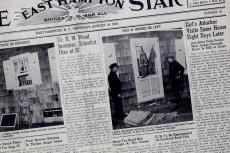About 75 people attended a rally in support of the state's marijuana legalization in John Steinbeck Waterfront Park in Sag Harbor on Tuesday.
David Falkowski, the owner of Open Minded Organics farm in Bridgehampton and CBD retail store in Sag Harbor, organized the event to raise awareness about the details of the law, and to encourage people to take an active role in developing local regulations for the use and sale of marijuana. "What I wanted to achieve today was to educate you, for us to get enlightened together, and then for us to leave here and have calm, productive conversations," he said.
The law legalizes marijuana for adult recreational use, home cultivation of up to six plants, public possession of up to three ounces, and the creation of dispensaries and lounges for on-site consumption.
"This doesn't mean that it's going to be out on the streets for everyone; in fact, it'll be off the streets," Nicole Ricci, a board member of New York Small Farma, a nonprofit that supports cannabis-related environmental, economic, and social justice initiatives, told the crowd. "It's going to be sold in sanctioned buildings, and people are going to be checking IDs." Since the criminalization of marijuana disproportionately impacted communities of color, she noted, the law also seeks to promote social equity by allowing those who have been incarcerated for marijuana possession to be released and to have the arrests expunged from their records.
Andrew Rosner, vice president of the New York Cannabis Growers and Processors Association, talked about the governing structure created by the law. It established a Cannabis Control Board and the Office of Cannabis Management, which will develop a regulatory framework for the production, distribution, and use of marijuana. The law, however, allows municipalities to opt out of issuing licenses for cannabis retail dispensaries and consumption sites. To do so, they would have to pass a local law by Dec. 31, 2021.
The new state law provides a guideline for East End residents to figure out what the cannabis industry will look like here, Mr. Falkowski said. Those who use marijuana will have to act responsibly, he said. "We need to be adults, this is adult-use cannabis." And those opposed to recreational use will need to be informed about the benefits of legalization. "We're looking to take the black market on the street and bring it into the light so we can improve the safety of our world and the products people now have the right to consume," Mr. Falkowski said. "People were buying, smoking, and driving, high on marijuana, before the passage of this bill."
He encouraged the crowd to visit a page on his farm's website that has a link to the law, as well as a state-sponsored study on the impacts of legalization. The study notes that criminalization did not curb the use of marijuana, but did make it far more dangerous to consume because of unregulated levels of potency, and contaminants. "Regulated marijuana introduces an opportunity to reduce harm for consumers through the requirement of laboratory testing, and product labeling," the study said, and also offers a safer option for pain relief, which could reduce reliance on the use of opioids.
One of the biggest impacts of decriminalizing marijuana usage, the study found, will be felt in communities of color. "Eighty-six percent of people arrested for [unlawful] marijuana possession in 2017 were people of color," it says. "Forty-eight percent were Black, and 38 percent were Hispanic. Only nine percent were white."




